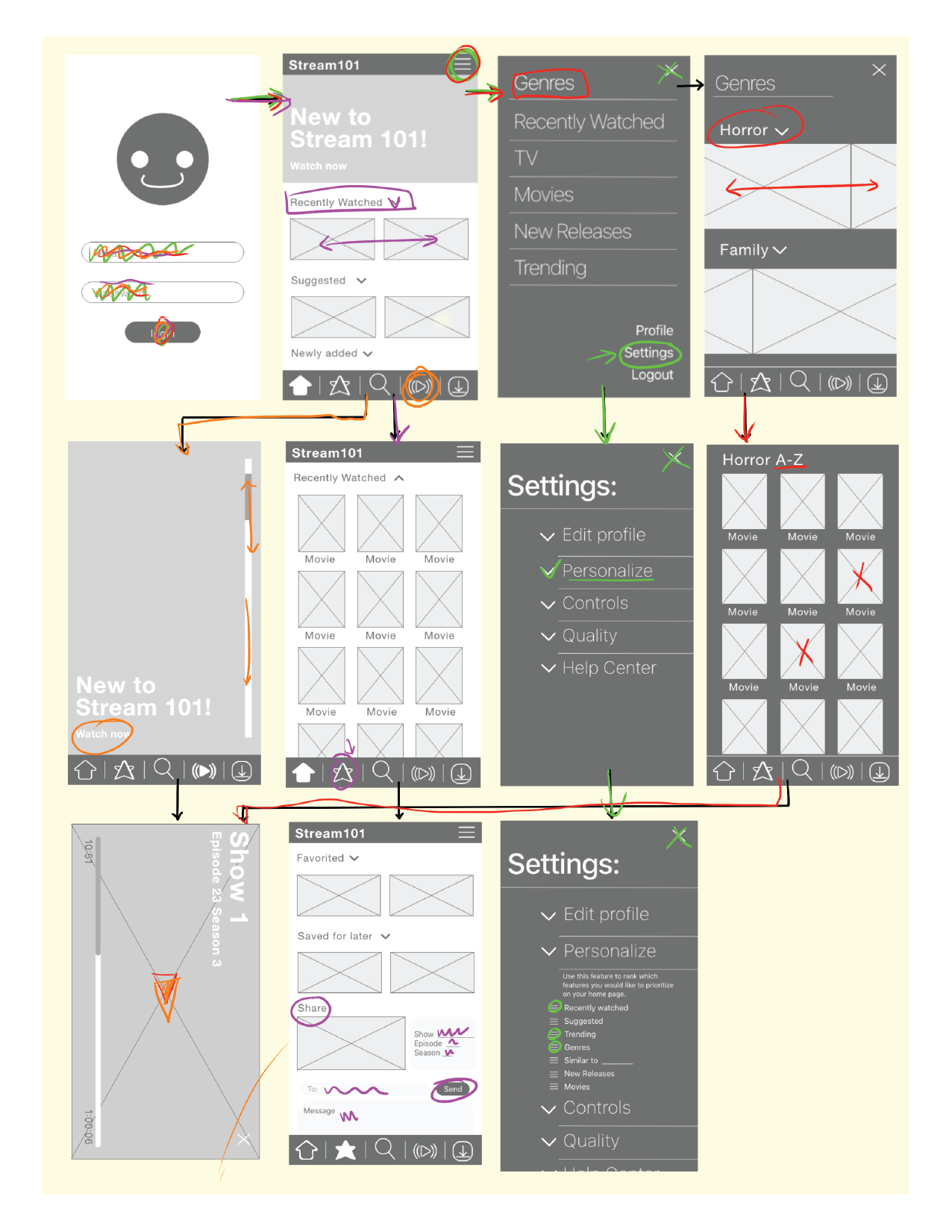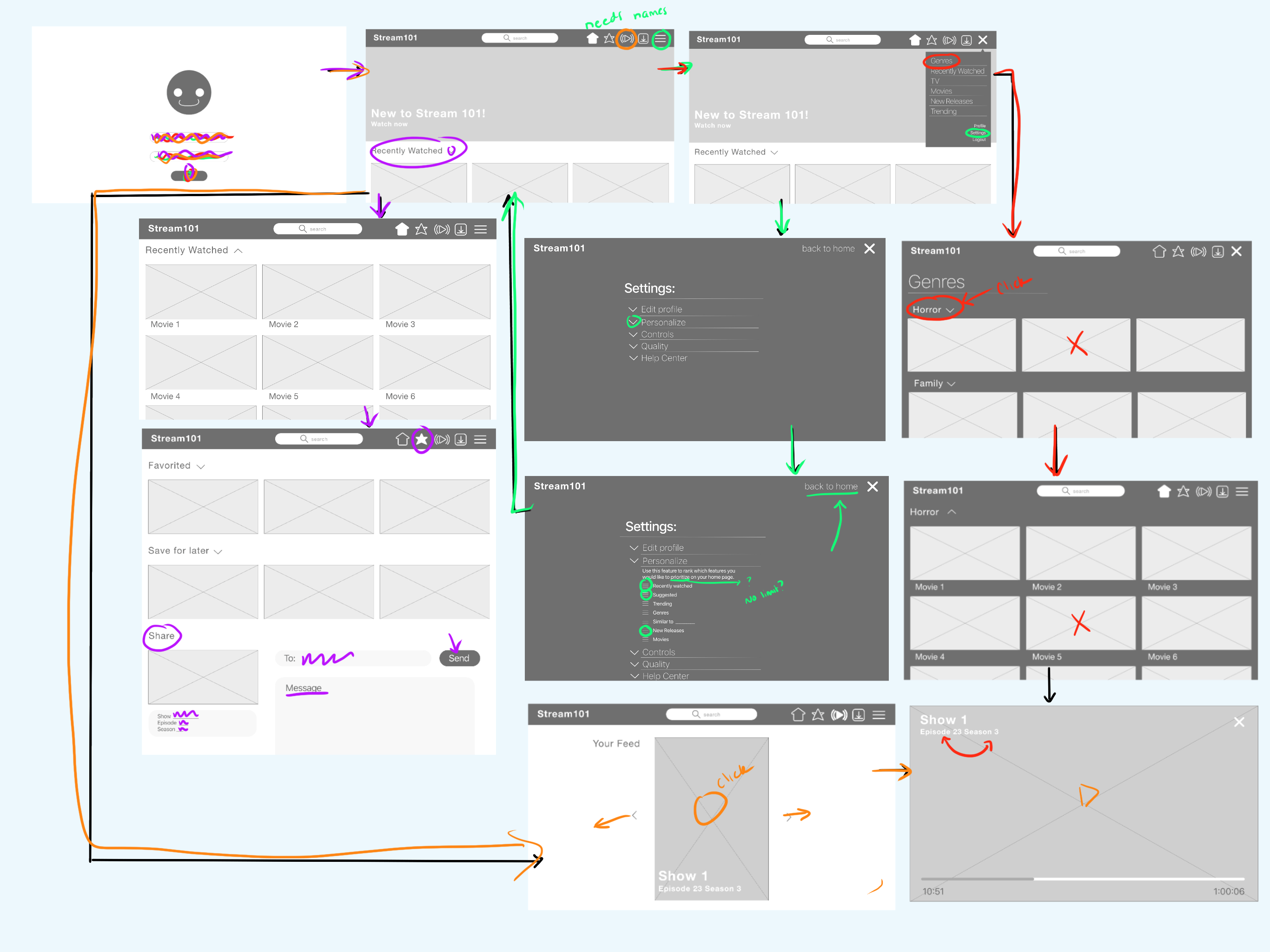A/D Device
fabrication / arduino / 3D printing
2019 — 2022
![]()
The 4 phases outlined below represent a research project completed over the course of 3 years. The tactile nature of interactive devices provided sensory input to the audience, stimulating their human desire to be immersed.
Phase 1 ︎︎︎
Phase 2 ︎︎︎
Phase 3 ︎︎︎
Phase 4 ︎︎︎ Professional work
fabrication / arduino / 3D printing
2019 — 2022

The 4 phases outlined below represent a research project completed over the course of 3 years. The tactile nature of interactive devices provided sensory input to the audience, stimulating their human desire to be immersed.
Phase 1 ︎︎︎
Phase 2 ︎︎︎
Phase 3 ︎︎︎
Phase 4 ︎︎︎ Professional work
Phase 1
Möbius (2019)
Materials: PVC pipe, CNC cut plywood
Process: programmed speakers, playing a shepherds tone, detect
the motion of an audience member standing at its center.
n
Showcased in the New Wright Gallery
Process: programmed speakers, playing a shepherds tone, detect
the motion of an audience member standing at its center.
n
Showcased in the New Wright Gallery
The Mobius strip is a non-orientable surface that exists with only one side and one boundary curve. This piece reinvents the characteristic features of the Mobius strip and invites its observers to explore both physical and sociocultral non-orientability. By triggering motion detectors, audience members can play a shepards tone. This well known auditory illusion is distinct for its paradoxically ever-increasing or ever-decreasing pitch. Synergizing physical and auditory non-orientability invokes an elevated state of disorientation and questioning. In what ways is our society disoriented? Through what mechanisms does perpetual interpersonal conflict contribute to social and cultural non-orientability?


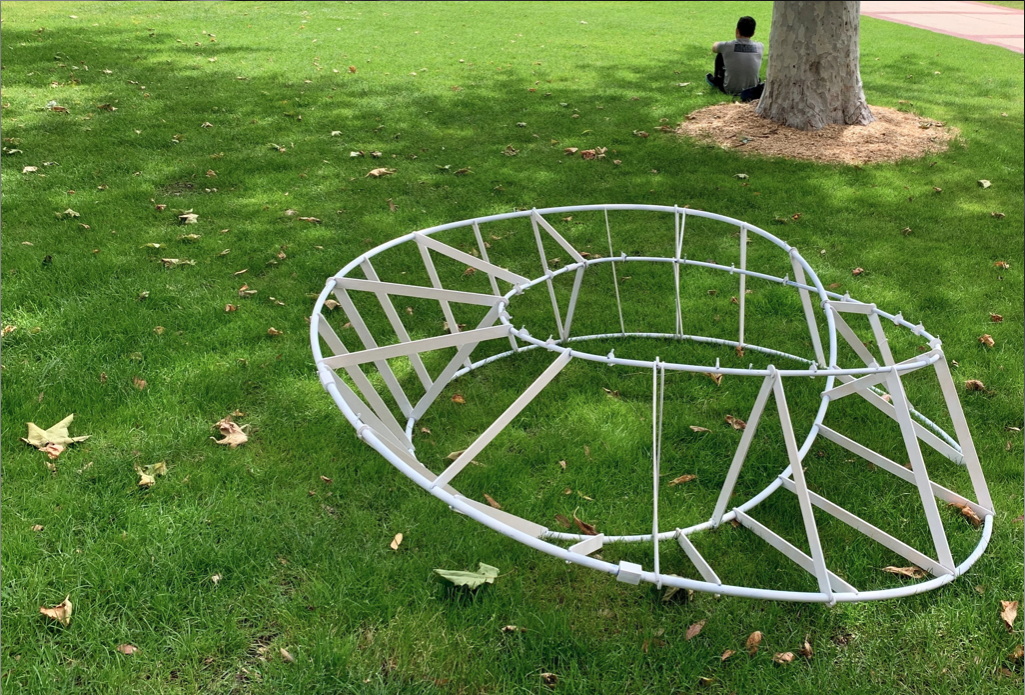
Phase 2
Automata (2021)
Materials: laser cut plywood, 3D printed parts, servos, arduino, photoresistor light sensor
Showcased in the New Wright Gallery
Materials: laser cut plywood, 3D printed parts, servos, arduino, photoresistor light sensor
Showcased in the New Wright Gallery
This piece is an attempt toward differentiating human from machine and the innate draw towards analog systems. In an attempt to break the process of which humans interact with digital devices on command, this piece explores the interaction between a simple machine and a playful audience. To further explore the metaphorical “game” at hand microcontrollers, wood fabrication and photoresistors are used to create an automata, completely erasing the human set factors from the equation. The result is a set of machines seen below exaggerating the cyclic need to “click” despite human factors.

Automata variation 1.0
Cognitive game; flip the switches
to turn off the light

Automata variation 3.0
evolved verion of 2.0, focusing on
design and aesthetic
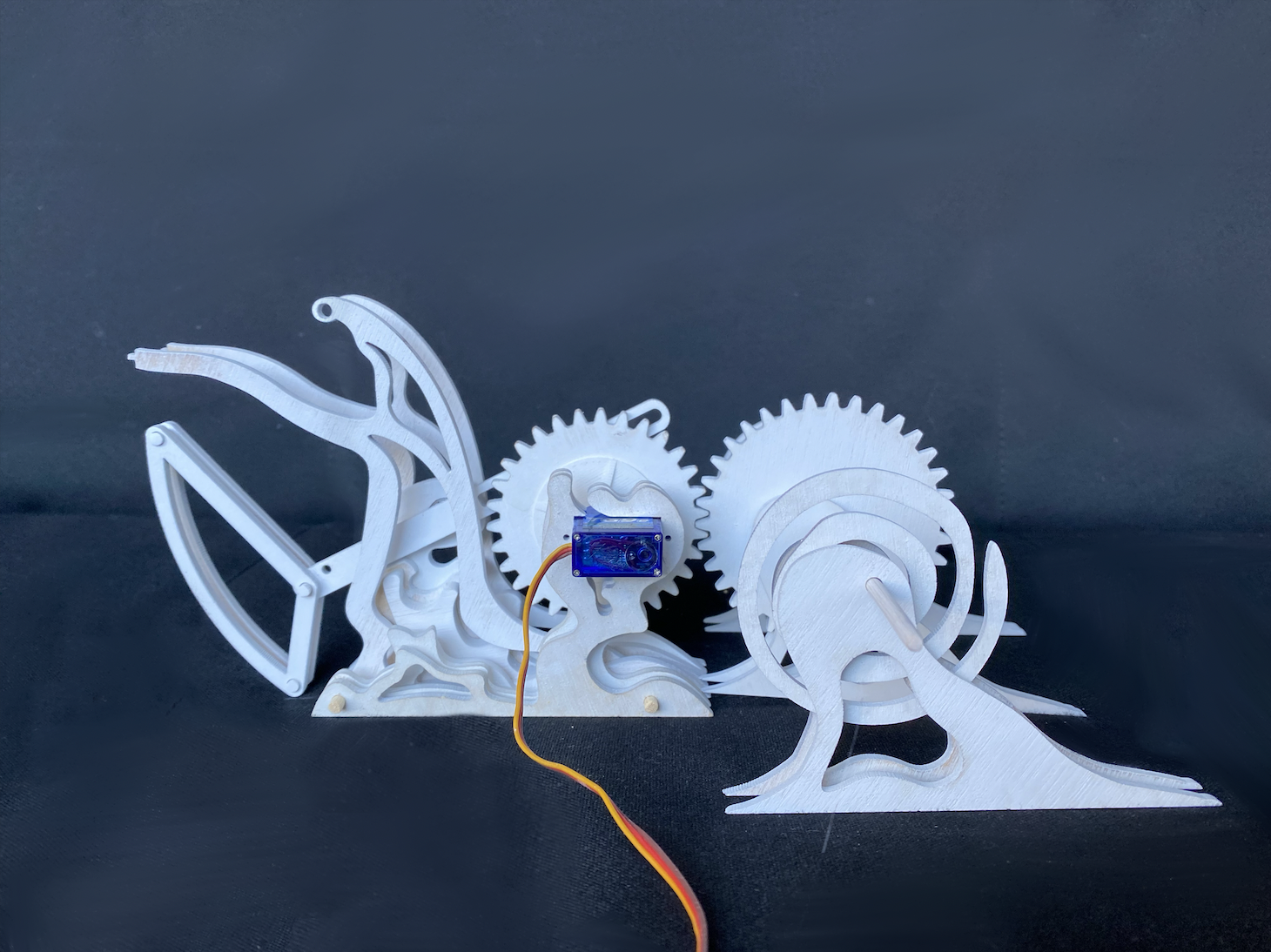
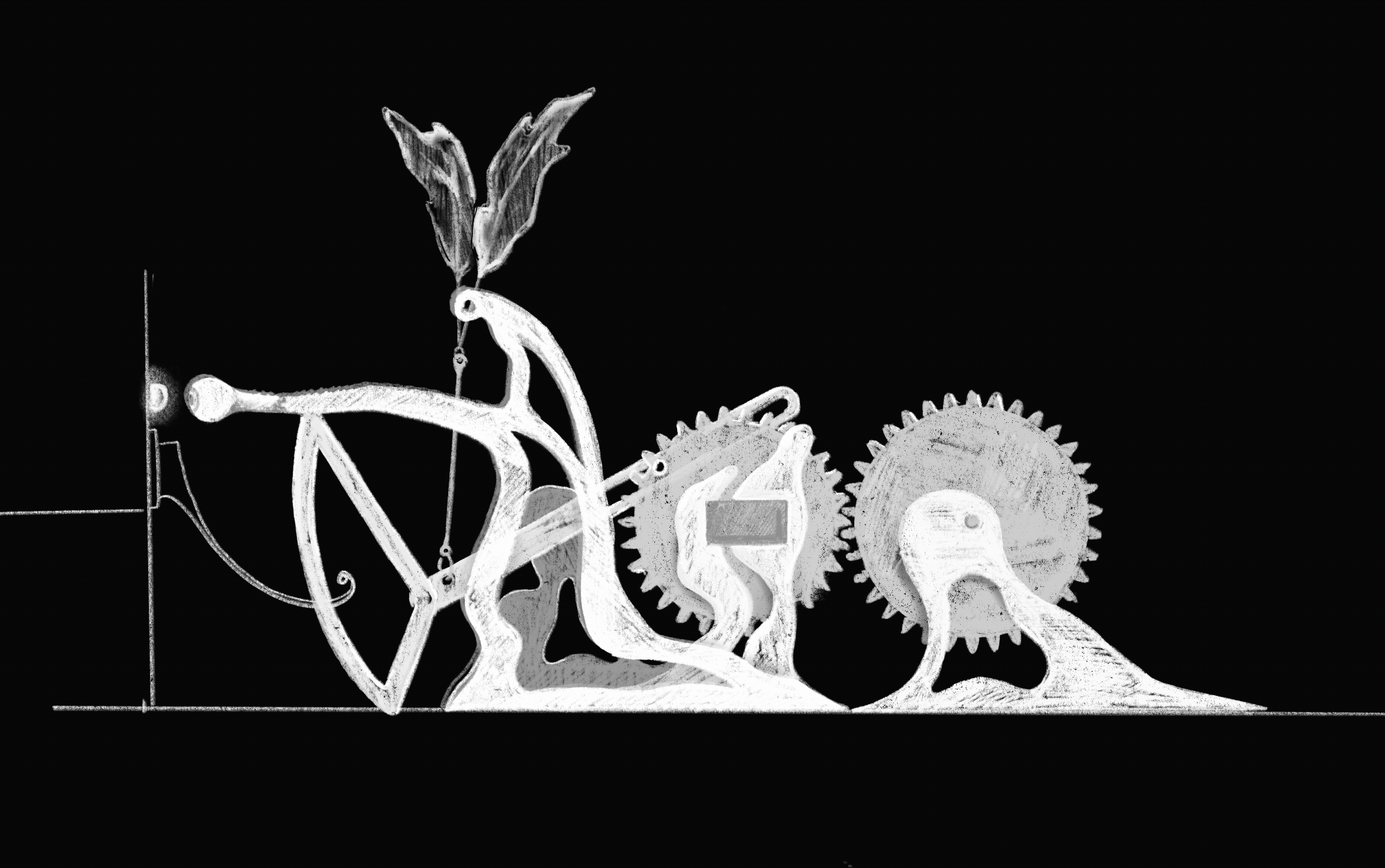
Automata variation 2.0
machine uses photoresistors to flip the switches
removing the need for the human

Phase 3
A/D Device (2022)
Materials: laser cut plywood, 3D printed parts, servos, arduino,
silicone, fiber optic cables, piezo sensors
Showcased in the Experimental Digital Arts Gallery
silicone, fiber optic cables, piezo sensors
Showcased in the Experimental Digital Arts Gallery
Phase 3 compiles the knowledge acquired from previous stages to convert complex phenomena, of desiring analog systems despite more efficient solutions, into a more digestible format.
The organic design of this piece was to bring back the natural instincts of the first phase while sticking with the completely tech driven aspect of the 2nd phase. The juxtaposition and the hypnotic light show generated by this piece explores the tactility of physical objects, creating a hands-on, thought-provoking environment for the audience.
The organic design of this piece was to bring back the natural instincts of the first phase while sticking with the completely tech driven aspect of the 2nd phase. The juxtaposition and the hypnotic light show generated by this piece explores the tactility of physical objects, creating a hands-on, thought-provoking environment for the audience.





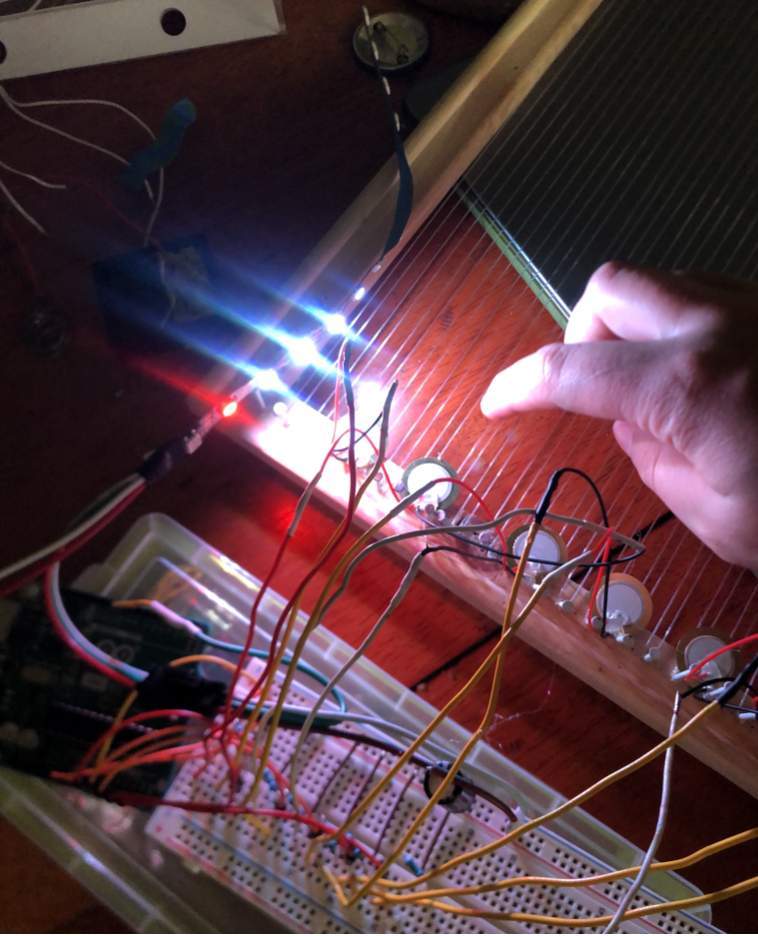
Phase 4
Gimbal Controller
Materials: 3D printed parts, potentiometers, arduino, large button
Worked in partnership with Cosm.
The prototype below is a playful exploration on the ergonomics of a hand and its relationship to a digital display. In conjunction with Cosm’s innovative display technology at their newly established venues, this prototype was developed as an interactive device for large-scale audience.
Phase 4 is a real world application of how necessarily tactility is to human interaction. The interactive device is designed to be intuitive yet exporable, with the mindset that the audience will only have a few moments to learn how to use the device. The simple controls move the audience in a x,y and even z pattern on the screen by rotating the inner and outer disks. The spherical nature of the device is meant to mimic the latitude and longitude of the curved digital display.
Phase 4 is a real world application of how necessarily tactility is to human interaction. The interactive device is designed to be intuitive yet exporable, with the mindset that the audience will only have a few moments to learn how to use the device. The simple controls move the audience in a x,y and even z pattern on the screen by rotating the inner and outer disks. The spherical nature of the device is meant to mimic the latitude and longitude of the curved digital display.



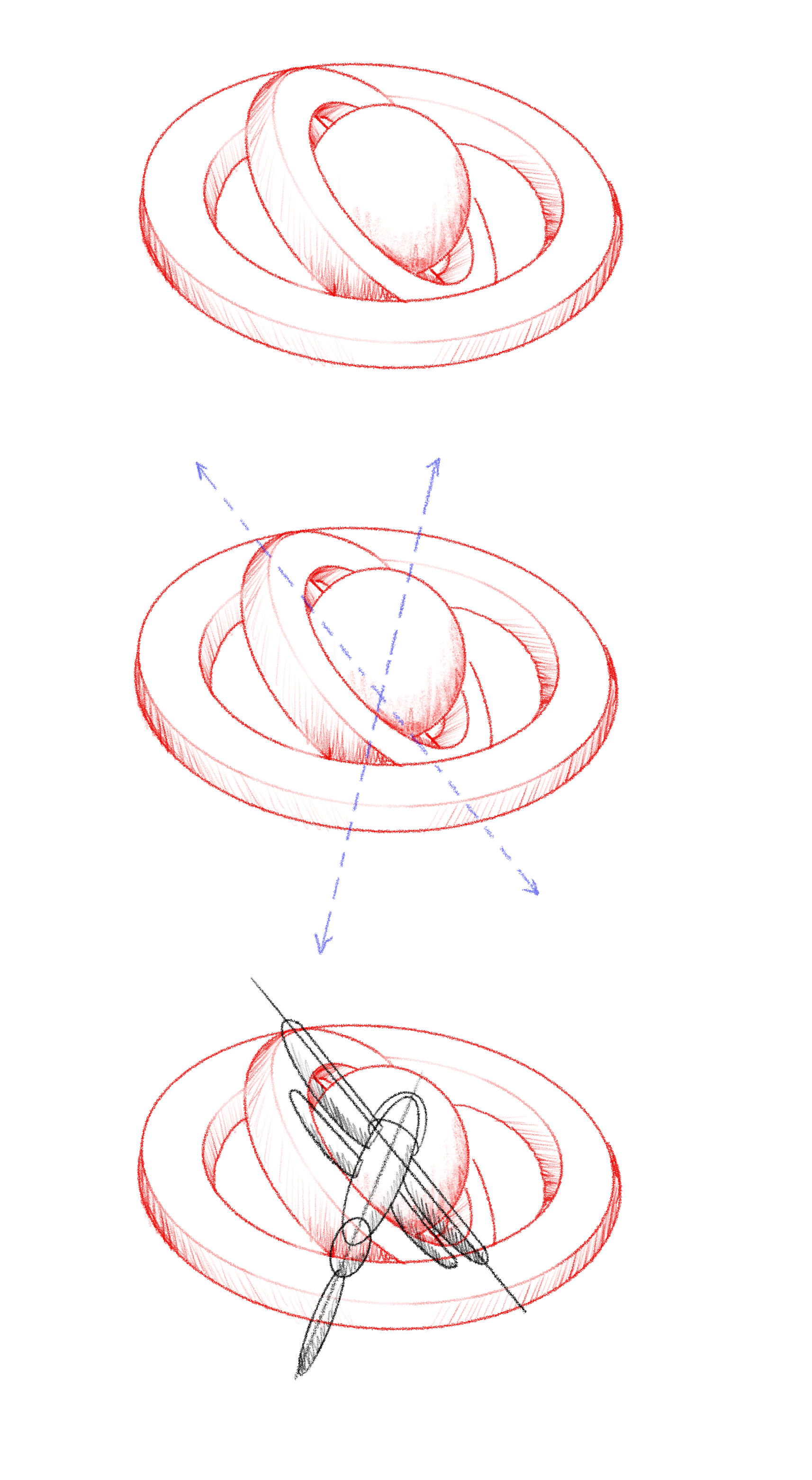
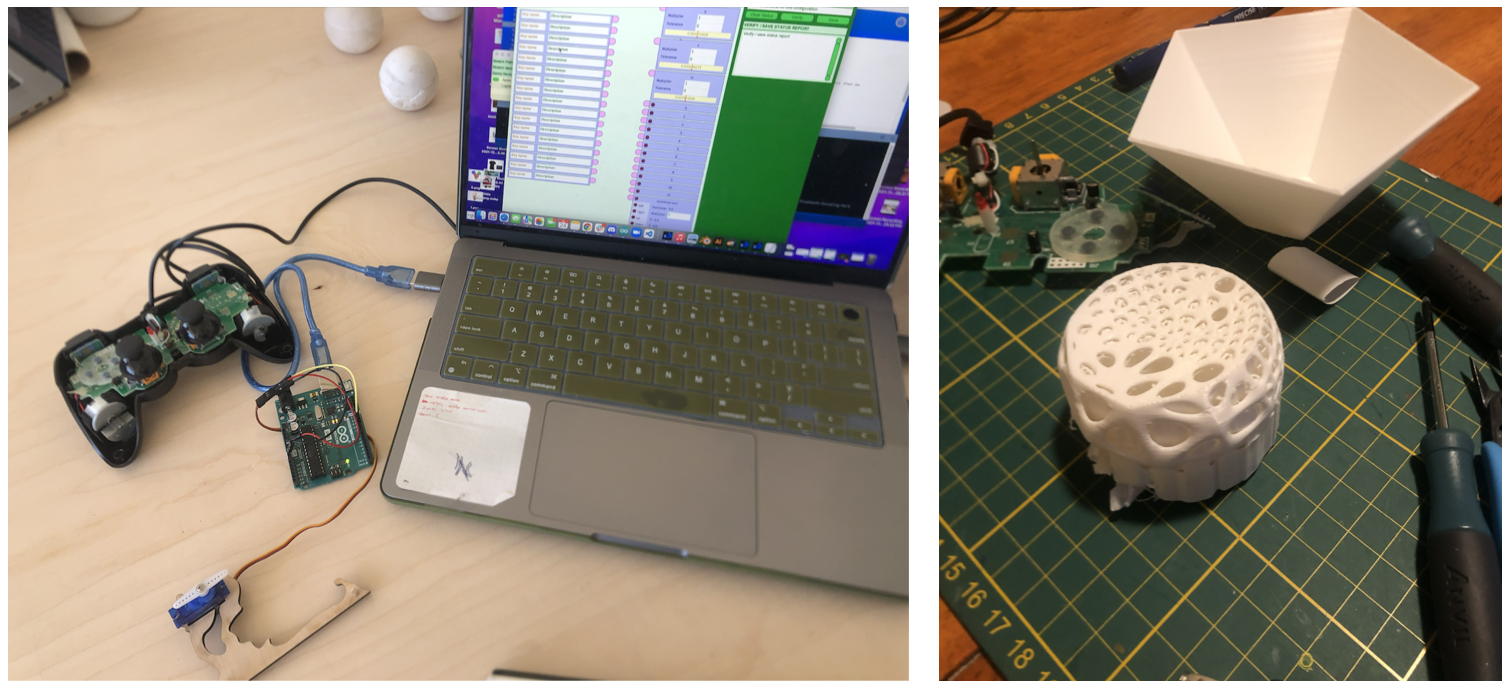
concepts involving simple mechanisms that are easy to use and mass producible︎︎︎



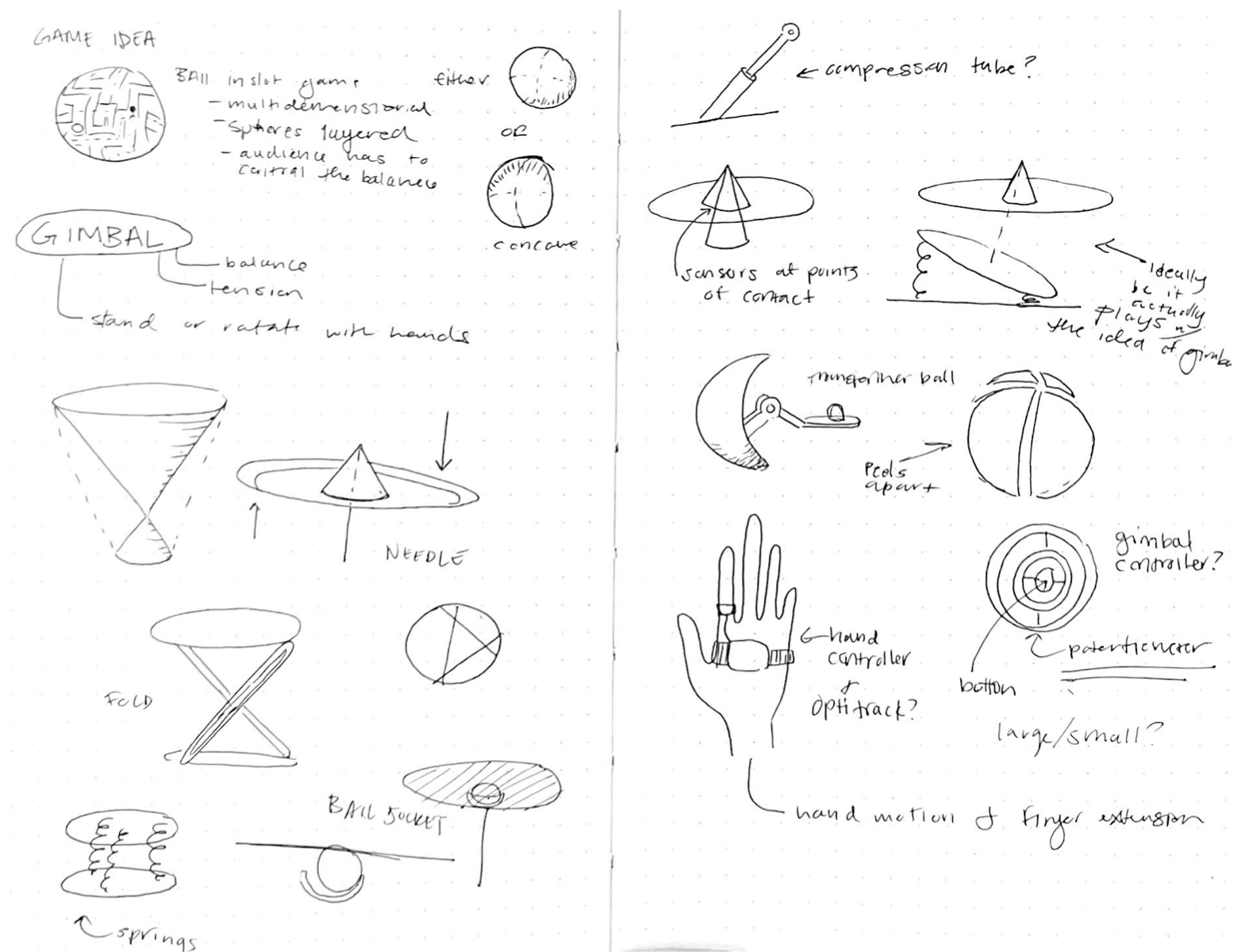
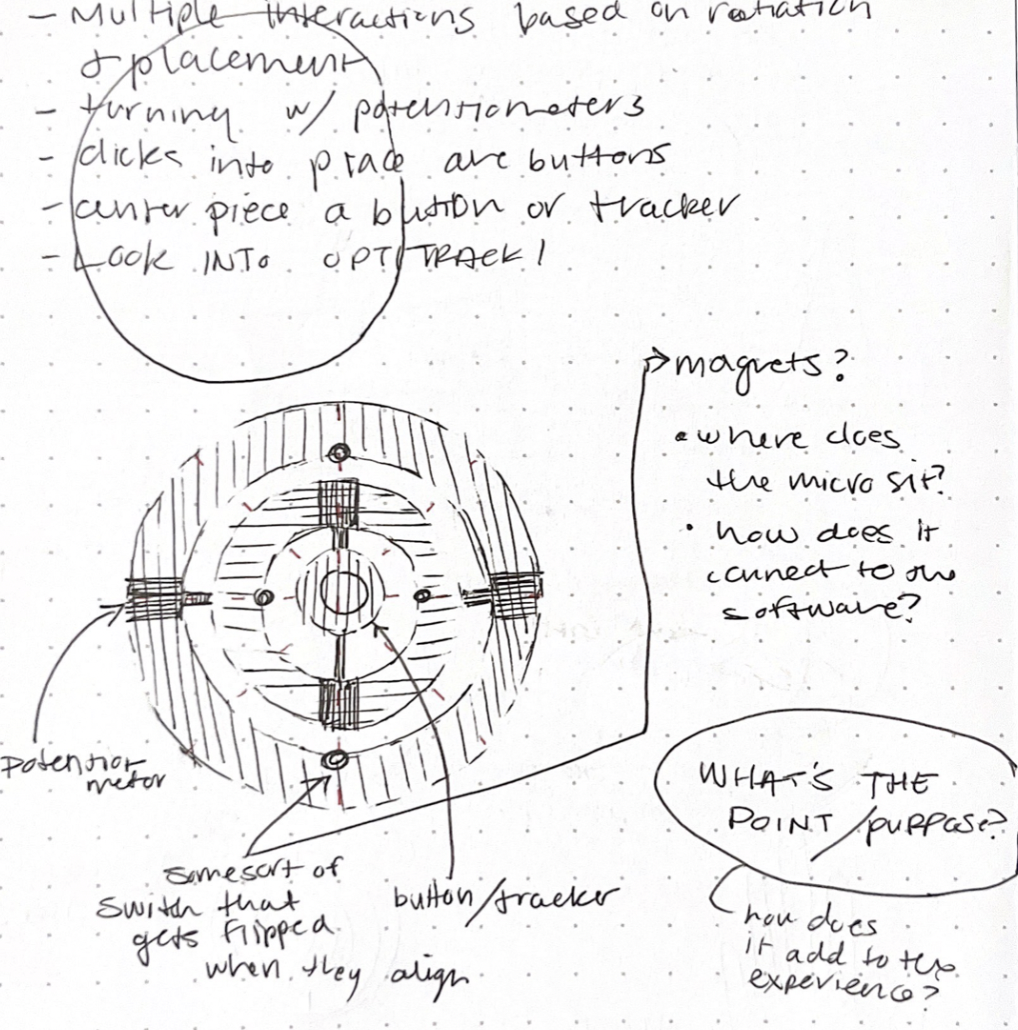
Worldbuilding
Unity / digital illustration / indesign / Blender
(2021 — 2022)
![]()
These two projects below worked in cohesion to build a world around misinformation. The 6 page dungeon was an exploration of character developement as well as story and plot. As a version 2 I redesigned the aesthetic and reworked the game into Unity.
Version 1.0 — 6 Page Dungeon
Version 2.0 — Unity Scroller
Unity / digital illustration / indesign / Blender
(2021 — 2022)
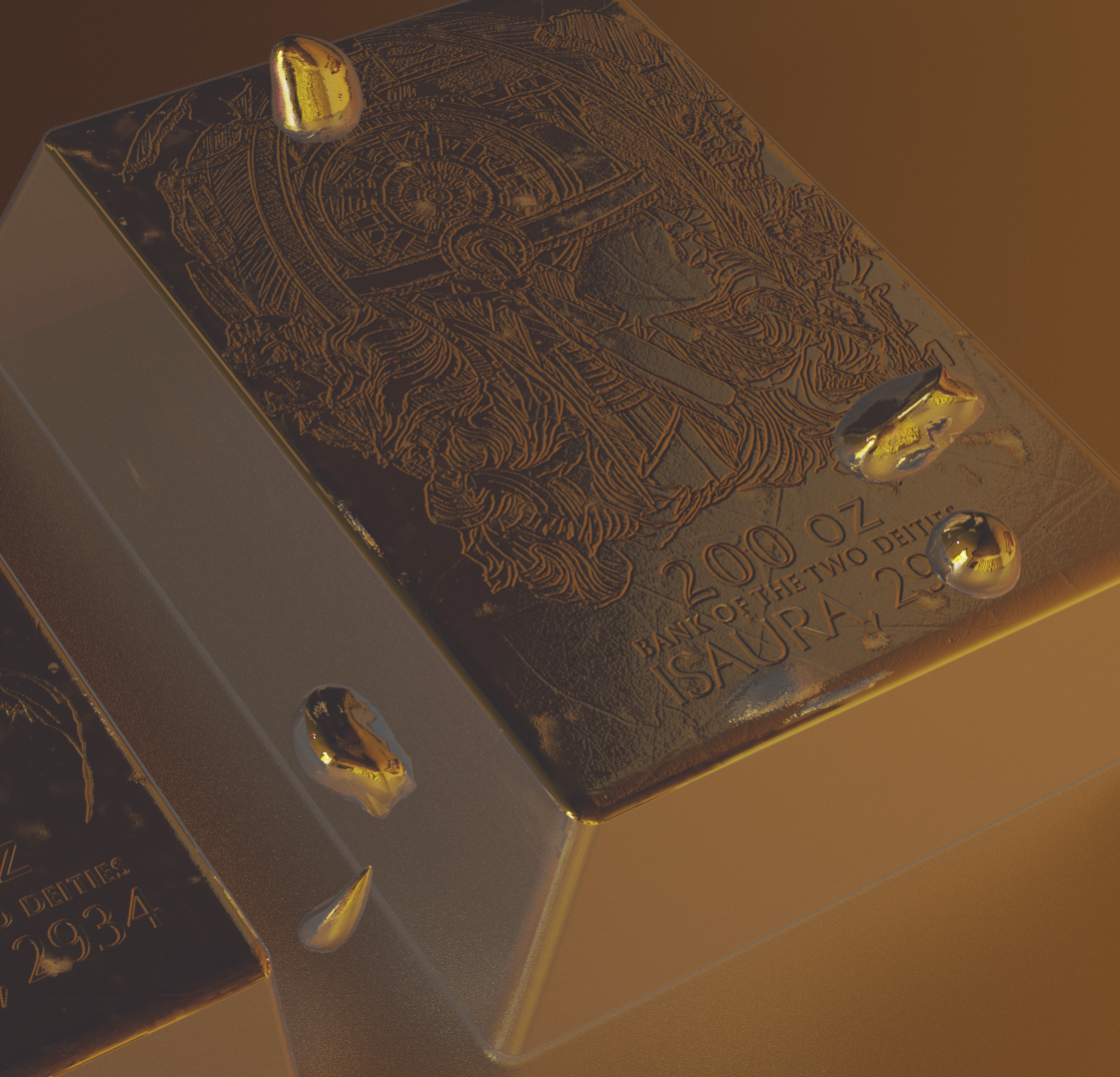
These two projects below worked in cohesion to build a world around misinformation. The 6 page dungeon was an exploration of character developement as well as story and plot. As a version 2 I redesigned the aesthetic and reworked the game into Unity.
Version 1.0 — 6 Page Dungeon
Version 2.0 — Unity Scroller
Version 1.0




Version 1.0
6 Page Dungeon
materials: digital illustration, indesign, illustrator
Welcome to the world of algorithmic supremacy where truth has become ambiguous, and a shadowy counterpart exists to corrupt the system you have always known as familiar. Your world's mode of operation is an engine of influence in which bots, like you, are the
backbone of its infrastructure. More now than ever, systems and software are designed to hinder your influence, but you know with aesthetics, familiarity, community, and a strong target audience that you won't be slowed by any antagonistic authority. To finally eliminate any opposing forces you must solidify your influential power and navigate through the core of the internet.
backbone of its infrastructure. More now than ever, systems and software are designed to hinder your influence, but you know with aesthetics, familiarity, community, and a strong target audience that you won't be slowed by any antagonistic authority. To finally eliminate any opposing forces you must solidify your influential power and navigate through the core of the internet.

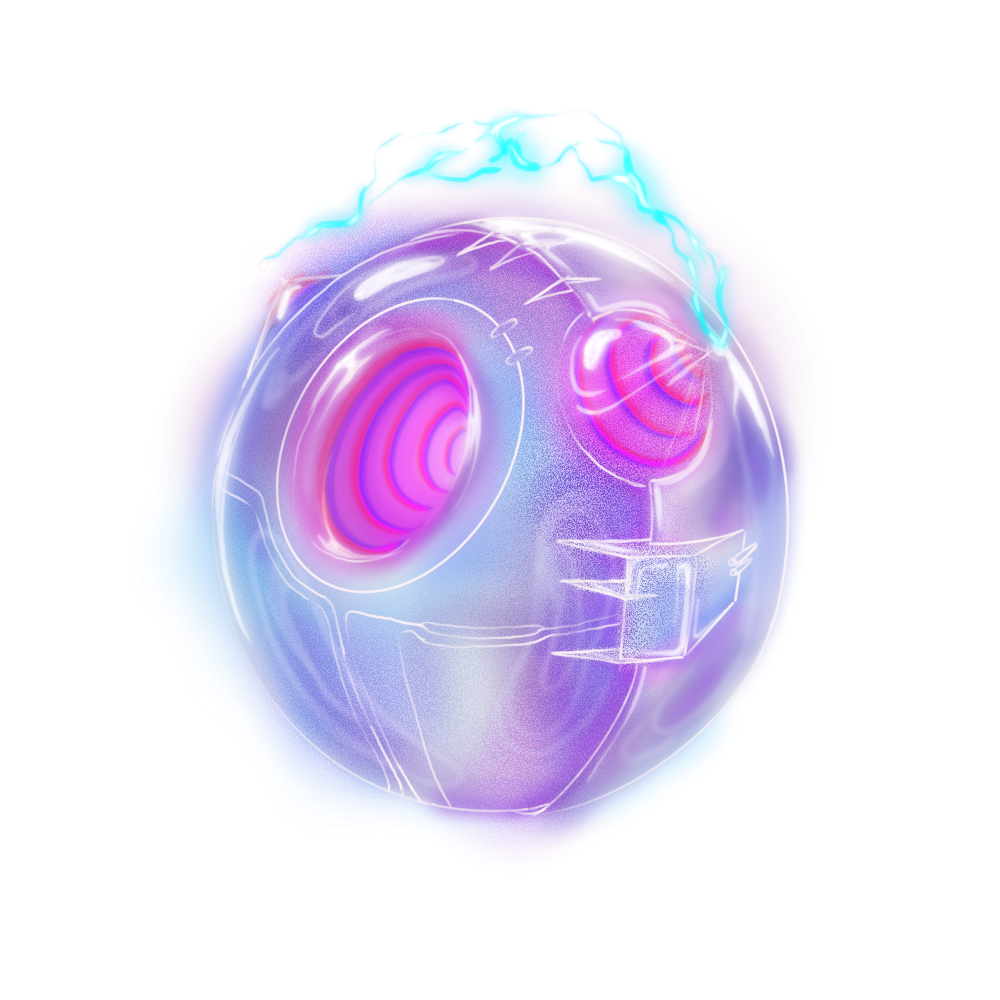
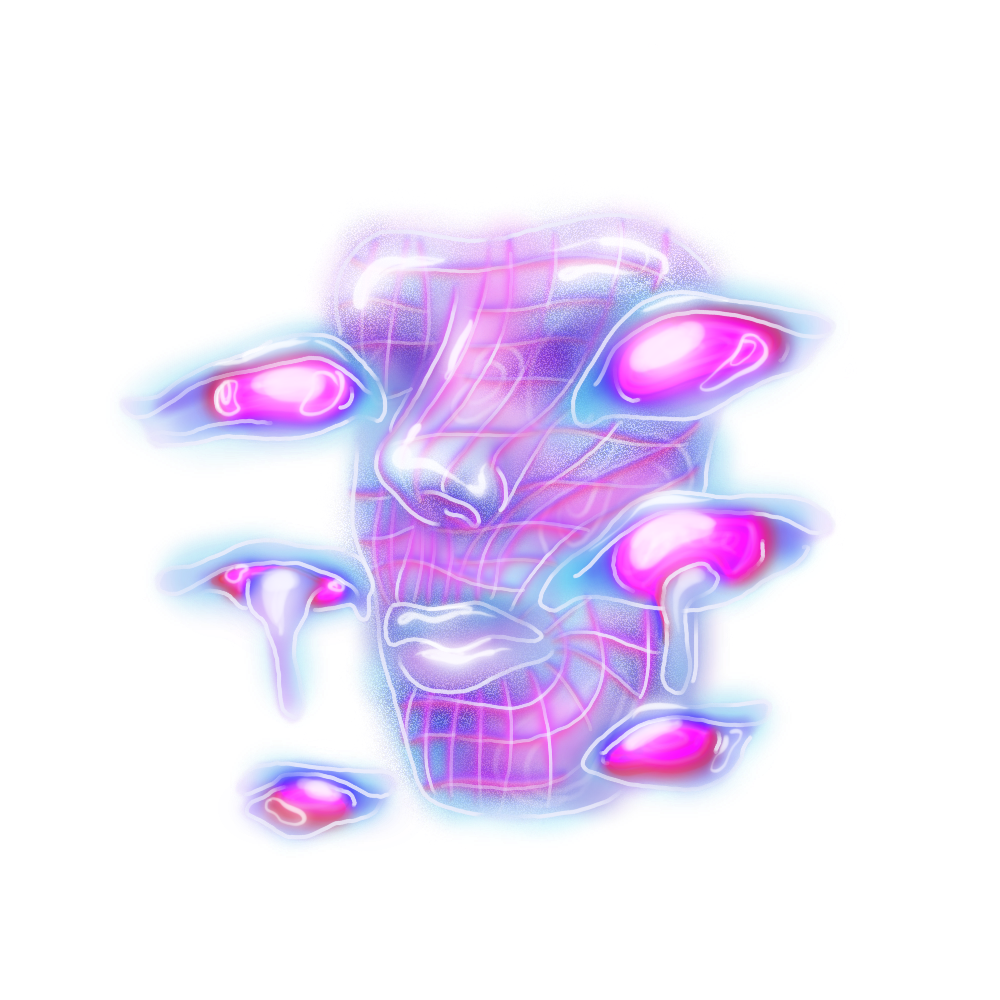


Version 2.0
Version 2.0
Contagion Capitol
materials: unity, digital illustration
Contagion Capitol
materials: unity, digital illustration
A 2D scroller game to expand upon the playable nature of misinformation. The user will navigate the space a bot to discover how to spread misinformation.
This world has currency as seen below, as well as notable history.
This world has currency as seen below, as well as notable history.
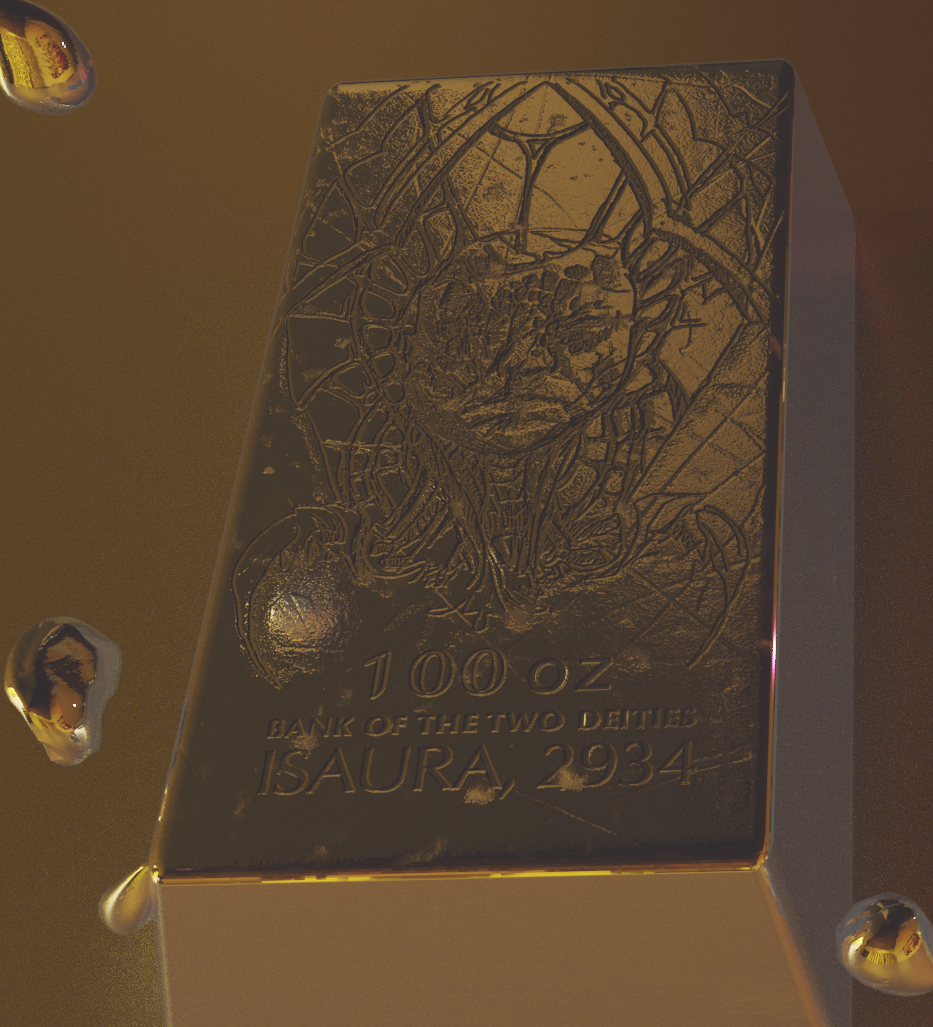


︎︎︎ level 1

︎︎︎ level 2


Gimbal Controller
fabrication / arduino / 3D printing
2022 — 2023
fabrication / arduino / 3D printing
2022 — 2023
Worked in partnership with Cosm.
The prototype below is a playful exploration on the ergonomics of a hand and its relationship to a digital display. In conjunction with Cosm’s innovative display technology at their newly established venues, this prototype was developed as an interactive device for large-scale audience.
![]()

Gimbal Controller
Materials: 3D printed parts, potentiometers, arduino, large button
Gimbal Controller is a real world application of how necessarily tactility is to human interaction. The interactive device is designed to be intuitive yet exporable, with the mindset that the audience will only have a few moments to learn how to use the device. The simple controls move the audience in a x,y and even z pattern on the screen by rotating the inner and outer disks. The spherical nature of the device is meant to mimic the latitude and longitude of the curved digital display.

Cosm Venue
Multitiered theater with viewing and interactive entertainment.
Multitiered theater with viewing and interactive entertainment.

Interactive device inlaid into arm of chair, each audience
member would have their own device.
member would have their own device.
Developed an interactive game to demonstrate
the X, Y, Z movement of the device on a screen.
the X, Y, Z movement of the device on a screen.

Technical drawings of device
3D printed prototype
3D printed prototype

L’appel Du Vide
Runway ML / After Effects
(2020)
Showcased in the UCLA Design Media Arts
Undergraduate Exhibit
Using machine learning, I data mined several thousand images and fed it to the software. Artificial intelligence is a beautiful way to visualize how ambiguous the phenomenon is. The virtual space I 3D modeled was created to draw the viewer in downward motion to simulate falling. The room itself was designed to be complex but simple enough to potentially be constructed in the future.
(2020)
Showcased in the UCLA Design Media Arts
Undergraduate Exhibit
Using machine learning, I data mined several thousand images and fed it to the software. Artificial intelligence is a beautiful way to visualize how ambiguous the phenomenon is. The virtual space I 3D modeled was created to draw the viewer in downward motion to simulate falling. The room itself was designed to be complex but simple enough to potentially be constructed in the future.
video showcasing the unfamiliarity of AI (listen with audio)
This space is a physical representation of the phenomenon known as L'appel du vide, or more commonly referred to as "the call of the void". This phenomenon explains the inexplicable urge to act despite knowing the assured negative consequences. The brain overrides any physical impulse but still demonstrates the mind's flexibility in imagining all possible outcomes. The ambiguity of machine learning is an authentic depiction of the intriguing, yet uncomfortable, feeling associated with L'appel du vide.
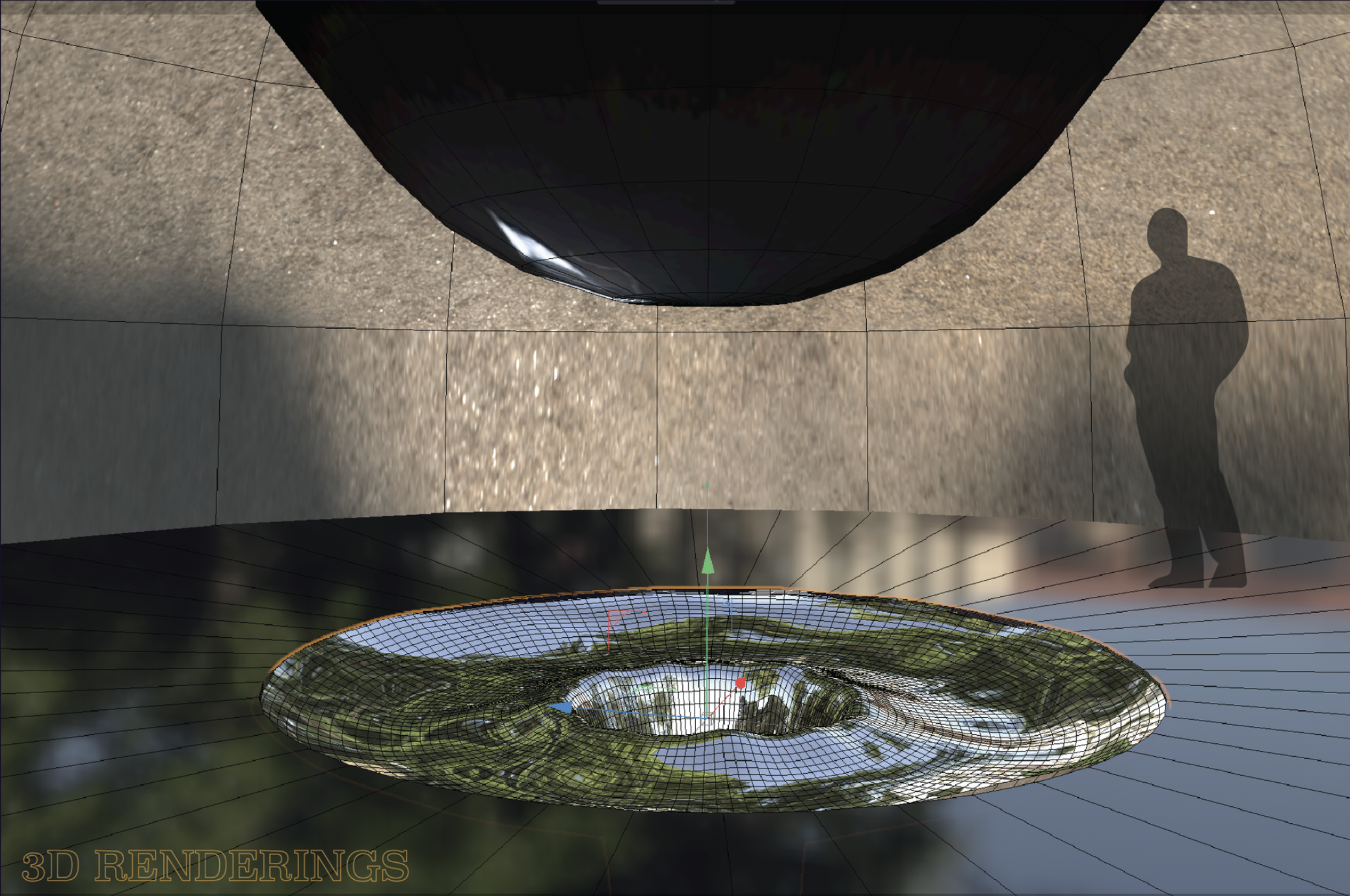
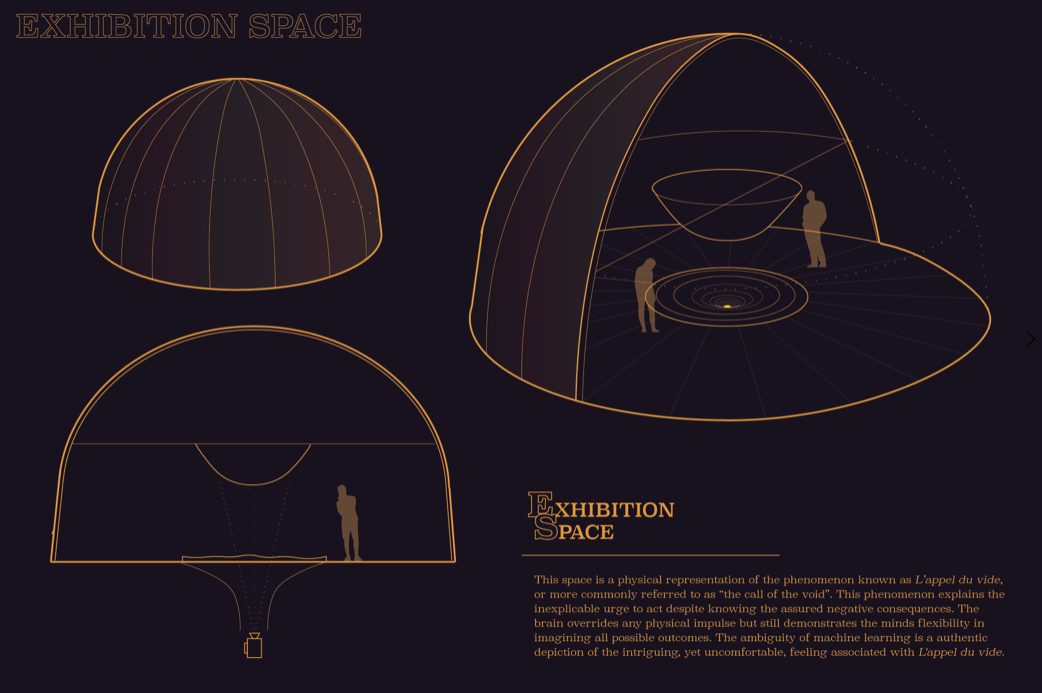
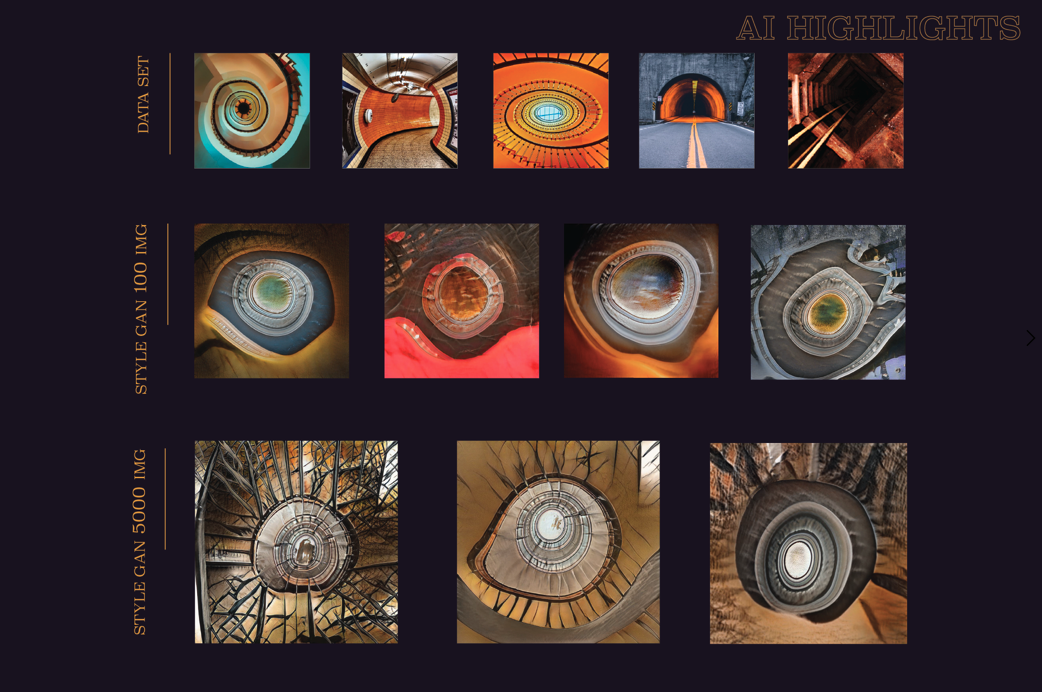
Graphic — Product
Professional Work1.0 - Bruins Vote ︎︎︎
2.0 - UCLA Student Affairs ︎︎︎
Personal Work
3.0 - Redesigned Streaming Service ︎︎︎
1.0 Bruins Vote
UCLA official voting website, used as a education resource for students and staff

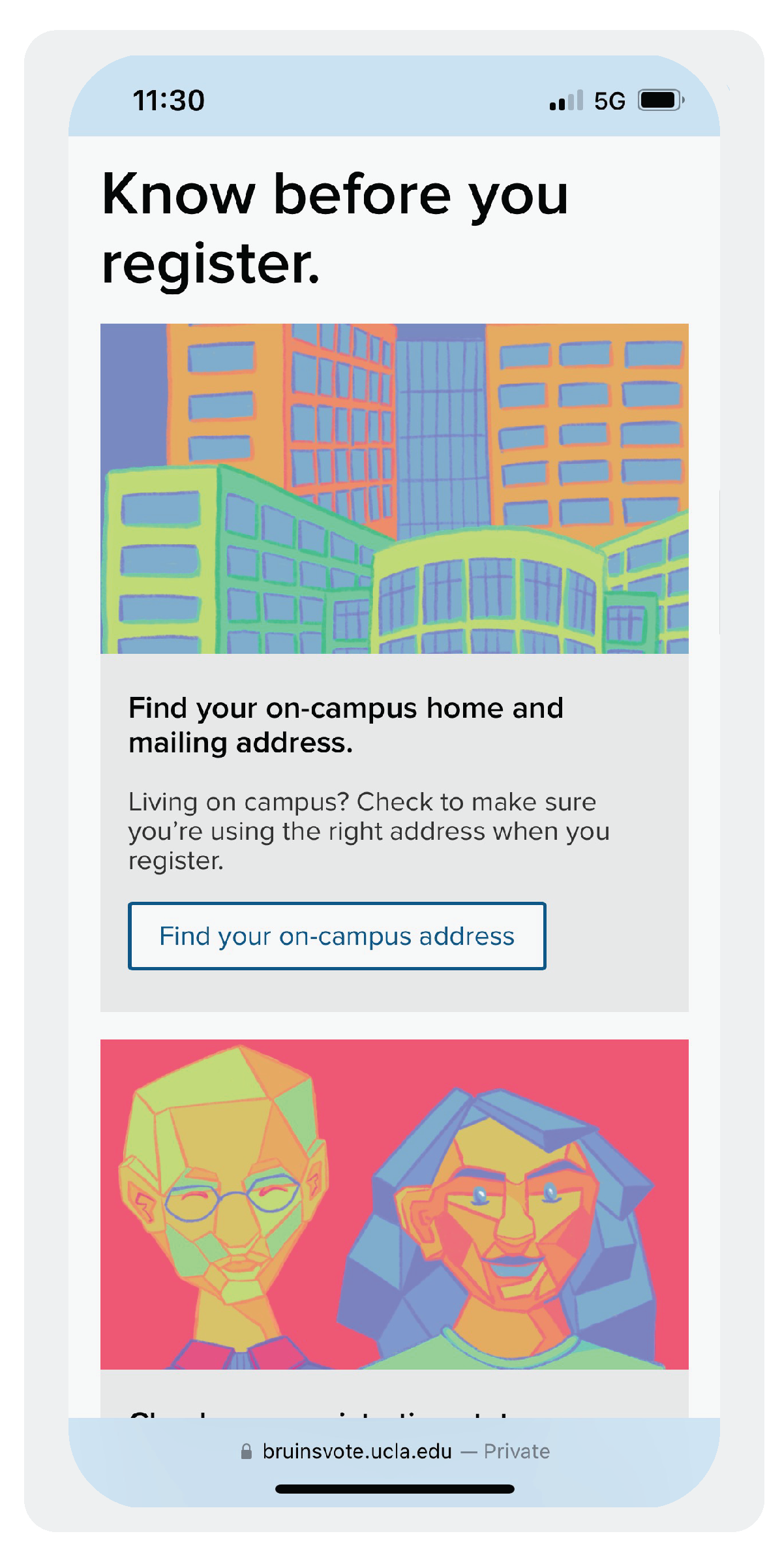

PROBLEM Redefining voting in LA county to UCLA students.
SOLUTIONCreated enticing graphics to bring the fun back into voting, as well as a colorful palette. We focused on accessibility and followed guidelines across all graphics.
2020-Present
https://bruinsvote.ucla.edu







2.0 UCLA Student Affairs
UCLA video series to inform students about resources on campus during Covid.
![]()
PROBLEMCreate motion assets that followthe UCLA brand guidelines and aremodular to a variety of texts.
UCLA video series to inform students about resources on campus during Covid.

PROBLEMCreate motion assets that followthe UCLA brand guidelines and aremodular to a variety of texts.
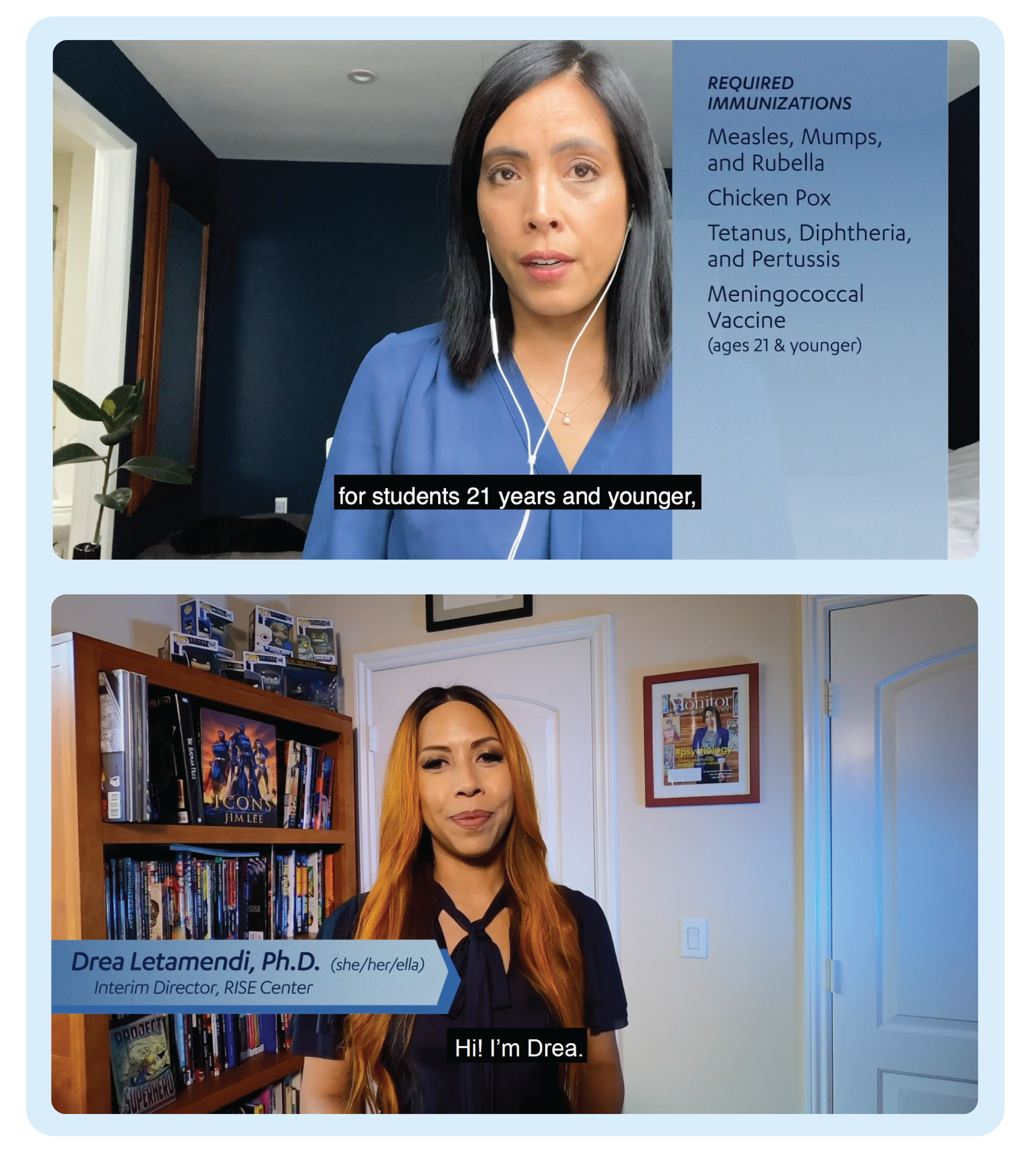


SOLUTIONCreated for main assets signed to shortphrases, links, paragraphs and namecards. Focused on accessibility and howto make education text enticing.
https://youtu.be/BkyGq14BlwQ
https://youtu.be/BkyGq14BlwQ
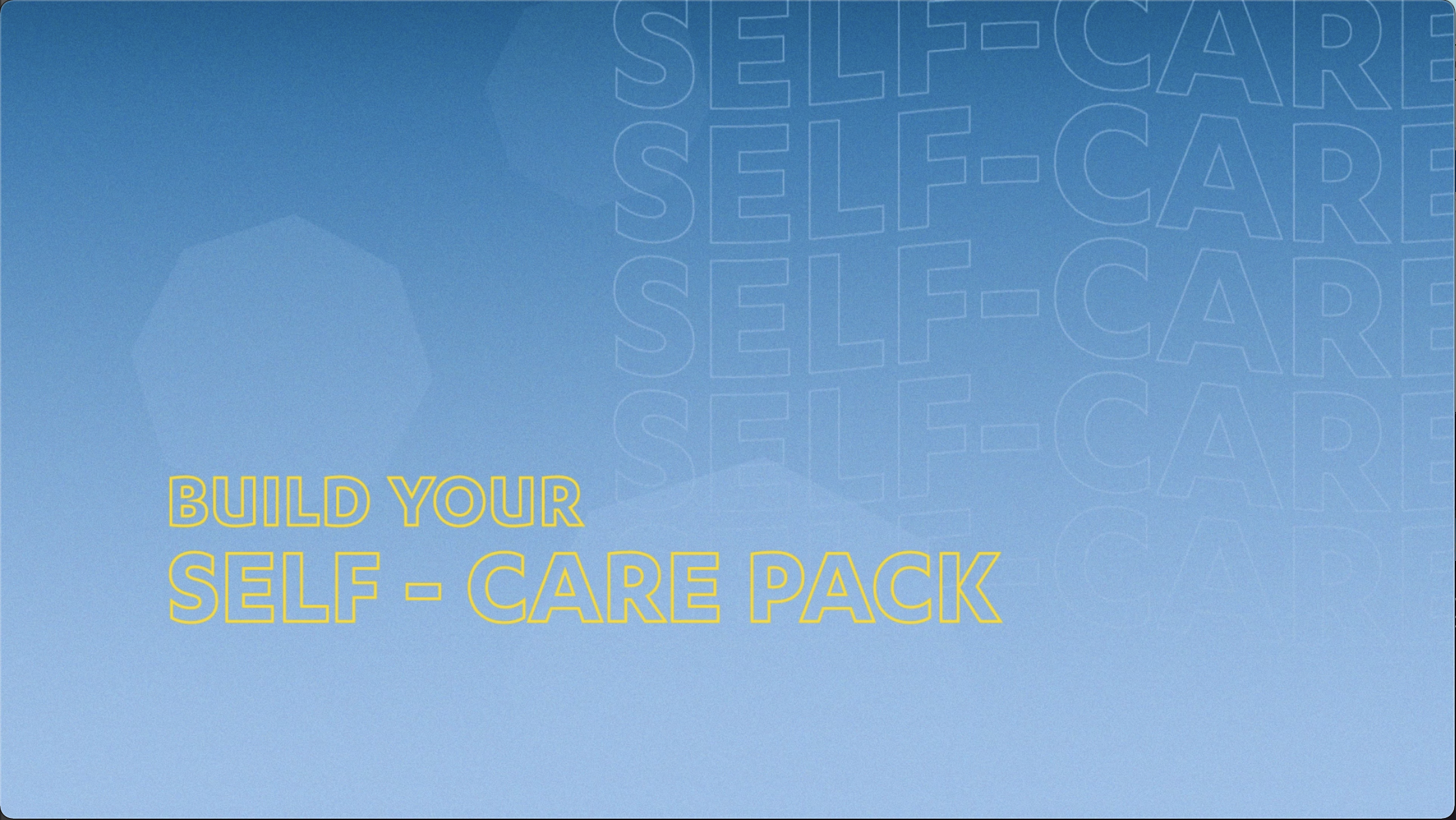


3.0 Streaming Service Redesign A unique take on the potential of streaming services, using Figma and Adobe XD.
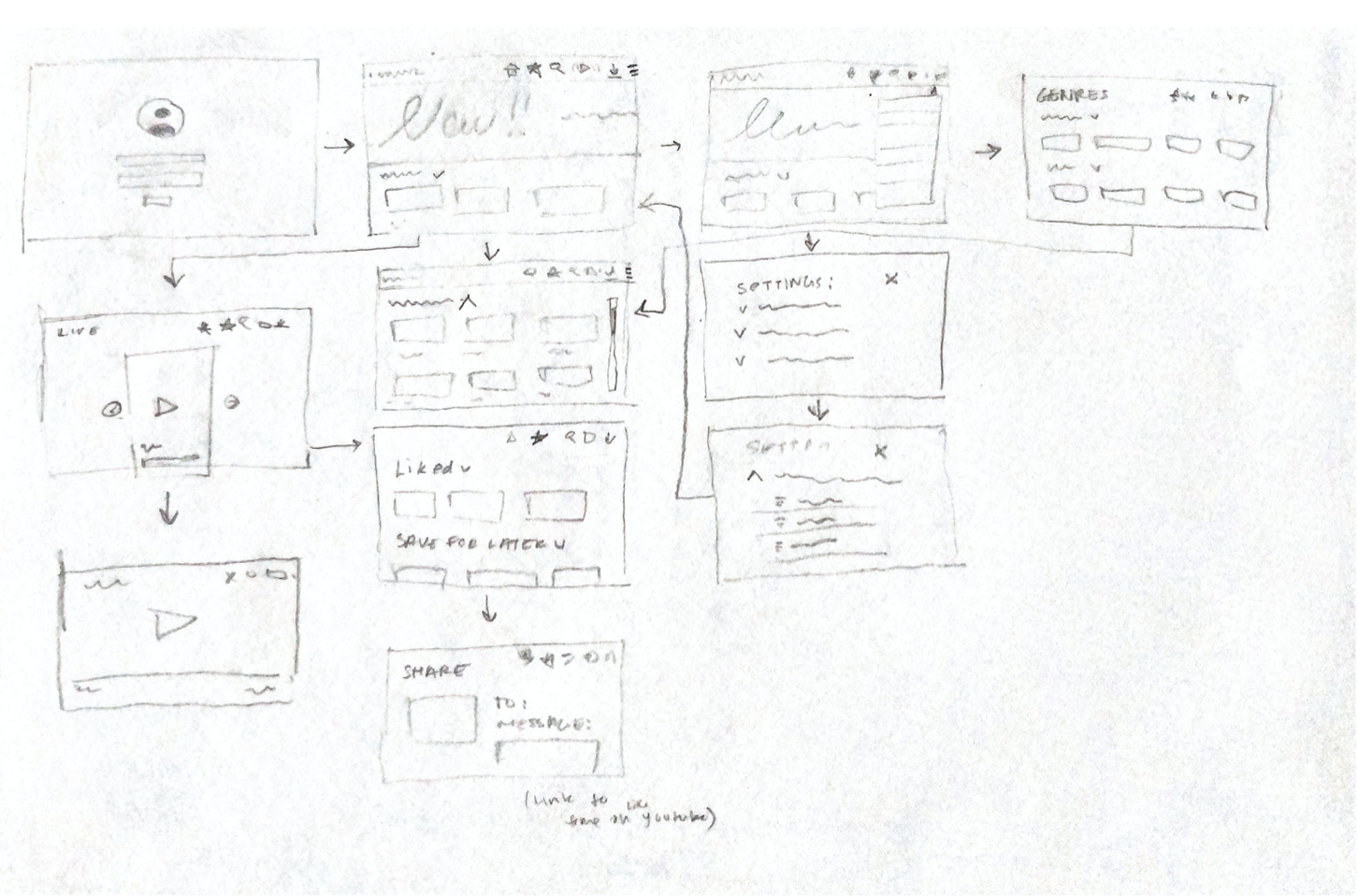
PROBLEM
It’s important in this day in age to find ways to destress and create a sense of relaxation. Simple pleasures to often appear as alone time with your personal device in a quiet area of your home. Since technology is so embedded in our everyday lives we often find solace in a good TV show and a nice snack. It is important that streaming devices are easy to use and intuitive, but most importantly that way there is no extra stress added. If the user’s cognitive load is burdened with over complicated tasks then the app/site will be doing the opposite of its given purpose.
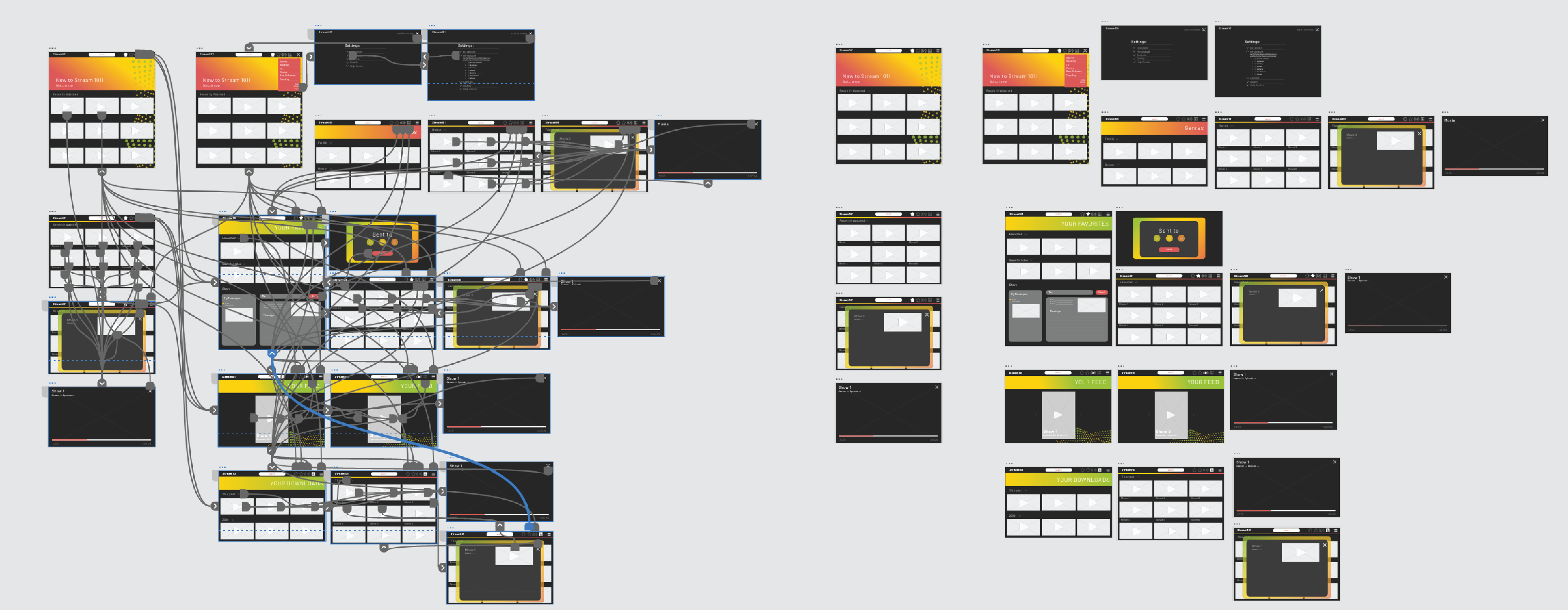
SOLUTIONThis prototype was designed keeping in mind middle aged women and what would assist in their interaction with the website. I kept in mind average technology experience/knowledge, accessibility of visuals and low cognitive stress. During the user’s experience they should have the ability to navigate the site to any extent they want, from searching a specific genre to being directed to a specific show.
